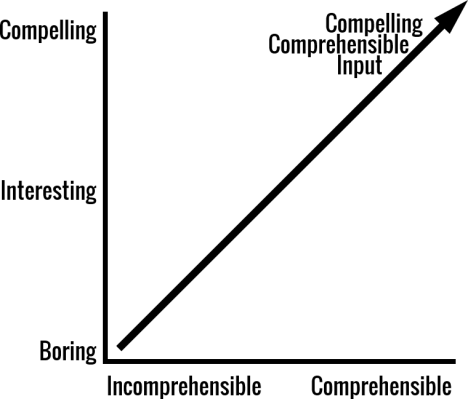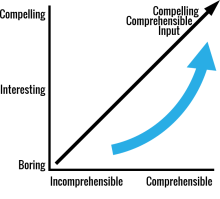In order to acquire new languages as effectively, efficiently, enjoyably, and effortlessly as possible, the most important thing is to have an abundance of compelling comprehensible input at every level.
Compelling comprehensible input means being able to hear the language you’re learning in ways that are both highly interesting and highly understandable to you.
Unfortunately, although we have both the technology and human resources to create it in abundance today, compelling comprehensible input remains needlessly scarce.
This is especially the case for total beginners, but it’s true for every level of learner, all the way up to advanced.
This blog, Beyond Language Learning, is about creating a world where compelling comprehensible input is available in abundance to every language learner.
You’re reading this, I hope, because you too are interested in the same kind of goal, thinking about how to get there, and perhaps even working already to build that world.
Maximizing interest and comprehensibility
I think a good way to think of how to go about creating more compelling comprehensible input is to look at its most important parameters, which are captured in the term itself: interest and comprehensibility.
We could visualize these as a graph with interest on one axis and comprehensibility on the other.

Level of interest would range from boring to interesting to compelling, and comprehensibility would range from incomprehensible to comprehensible.
Of course, we want input that rates highly on both axes, placing it high up and far to the right: highly compelling and highly comprehensible input.
Let’s look at some examples of input that would represent the four quadrants on this graph: input that’s boring and incomprehensible, input that’s comprehensible but boring, input that’s compelling but incomprehensible, and input that’s compelling and comprehensible.
Boring and incomprehensible input
It’s a bit difficult to think of a good example of this, but what comes to mind is bad immersion combined with “traditional” language teaching: when a teacher who doesn’t speak their students’ language tries to teach them his or her language by giving grammatical and other explanations, and drilling sentences that have no meaning for the students.
The teacher isn’t using anything like non-verbal communication or even translations that would help make what he or she is saying more comprehensible to the students.
The students are hearing and repeating things they don’t understand, and even if they could understand, they would find it boring anyway.
It goes without saying that practically no acquisition can happen under these kinds of conditions.
Comprehensible but boring input
How about input that’s comprehensible but boring?
We get this kind of thing if we take the aforementioned “traditional” language lesson that uses things like grammar–translation or drills, and add translation or non-verbal communication like pictures to make the language understandable.
A video on YouTube gives an example of such content: an audio recording plays sentences like “It’s a book” and “It’s on the table”, which are made comprehensible by pictures that have numbers to match with the sentences in the recording.
It is labelled an example of “comprehensible input in an English language course” but it’s so boring and irrelevant as to be a poor example of comprehensible input.
Dr. Stephen Krashen, who popularized comprehensible input and has more recently advocated for compelling input, would I think describe this kind of input as “trivial”.
As he wrote of mechanical drills that focus on the form of the language rather than communicating meaning: “while [they] may be understood, they are understood only in a trivial sense.” (p. 103, Second Language Acquisition and Second Language Learning)
In other words, these kinds of comprehensible input aren’t communicating anything meaningful to the learner, or of real interest to them.
Another example of this is the widely known Rosetta Stone apps and software, which are based around matching words or phrases in the target language to pictures.
When many people hear about comprehensible input-based teaching, their first comment is that it sounds like Rosetta Stone.
But in his critique, Krashen “conclude[s] that Rosetta Stone presents a tepid version of comprehensible input”.
“[I]n the samples I have seen,” he writes, “the input is not very interesting, and a long way from compelling, hypothesized to be the most effective kind of input.”
Much of the content does not seem much more interesting or relevant than the mechanical drills that Krashen wrote about decades earlier.
We don’t really care that “They are cooking” or that “The man is eating” any more then we care whether or not “John is a student”.
On the drills together with conversation activities, Krashen concluded that “they may succeed in encouraging some language acquisition, but I think the second language classroom can do much better.”
Echoing his words, I would say we can do much better in creating comprehensible content that’s also interesting.
As I’ll discuss further, I think it’s relatively easy to create content that’s not only highly comprehensible but also of at least some relevance and interest to learners.
Compelling but incomprehensible input
Countless examples of experiences and content fall into this area: they’re really interesting, but don’t end up providing much comprehensible input.
I think of exciting immersion experiences people have in countries where the language they’re learning is all around them, but they’re just not yet at a level where they can pick up much of it.
This is because the people around them aren’t communicating in a way that makes the language highly understandable at their level.
Another example is many “authentic resources”, for example, media like TV programs that are designed for other native speakers of the target language.

When I was acquiring Mandarin through just watching Chinese videos and guessing for meaning because I couldn’t find any content or classes that deliberately provided comprehensible input, I watched and rewatched the Chinese TV drama series 蜗居 (Wōjū, translated as Dwelling Narrowness or more literally Snail House, meaning “humble abode”).
I was gripped by the realism of the series and its story of two sisters struggling with life in a modern-day Chinese city, with the themes it addressed like high real estate prices, corruption, and social change.
But although it was so compelling, at my low level of Mandarin I hardly understood any of the language that was used.
I could broadly understand what was going on, but most of the dialogue went way over my head, so I didn’t acquire very much language at all from watching the show.
I would have acquired far more from content that may have been less compelling or interesting, but far more comprehensible from moment to moment.
Compelling and comprehensible input
When I think of input that’s comprehensible and compelling, I think of my best experiences with the AUA Thai Program, which uniquely aims to provide hundreds of hours of input that is both these things for Thai learners, from the total beginner level on up.
For beginners, this often involves the teachers acting out things and talking about them entirely in Thai in ways that are funny and outrageous, using non-verbal communication like pictures, props, and gestures to make it all understandable.

In one class I remember, the teacher used a teaching clock to ask students in graphic terms what time they went to the toilet that morning.
Some students appeared shocked that anyone would talk about this in a language school, but it certainly had everyone’s attention and had everyone understanding what was being said, with reactions ranging from laughter to disgust.
If you were wondering about the thumbnail for my video about AUA and the Automatic Language Growth (ALG) methodology it uses, it was inspired by this and similar bathroom-related topics, which are very frequent at the beginner level.
In more advanced classes, where students already understand some Thai and so require less non-verbal communication, a teacher’s personal story or discussion of a social problem might have students on the edge of their seats.
A more recent example of compelling comprehensible input I’ve discovered is the Mandarin Companion novels for Chinese learners.
These stories are based on older Western novels and adapted to Chinese settings, and use limited vocabulary sets with a lot of repetition for ease of reading and understanding.
Audio versions of the books are available, and the books have some pictures that make it clearer what’s happening in this story.
I bought one of these novels and the audio and I found that at my level of Chinese, I could listen and follow along easily, and understand it so well that I could effortlessly pick up new words and structures.
I became so absorbed in the story that I almost forgot that it was in Chinese.
This is the very definition of compelling input, according to Krashen: “Compelling means that the input is so interesting you forget that it is in another language.”
Of course, I already have a lot of experience with Mandarin, and some reading ability, so this kind of content wouldn’t be comprehensible to a beginner.
How to create compelling comprehensible input in abundance
Having surveyed these main kinds of input, let’s come back to the question of how we can create an abundance of input that’s both highly compelling and highly comprehensible for language learners at every level, but especially beginners.
While there’s certainly a need at higher levels, it’s at the very beginner levels where compelling comprehensible input is most scarce and the need is greatest.
I think the beginner level is also where it’s most difficult to create comprehensible input that’s both highly understandable and highly compelling, although at the same time, I don’t think it’s really that difficult.
Much of it is a matter of developing the ability to make language comprehensible to beginners using non-verbal communication like gestures and pictures.
I don’t think this requires having to teach a lot that’s new as much as just bringing out abilities that people already have and use.
We already naturally use a lot of non-verbal tools to help us communicate, even with those with whom we share the same language.
Ironically, when it comes to helping people acquire a new language, people often seem to forget about these tools that they use already at the very time they ought to be maximizing their usage to aid the learners’ comprehension.
This is probably largely because of ingrained ideas about languages needing to be taught, which leads people to focus on the language rather than communicating meaning.
Focus on maximizing comprehension before interest
Because of this “comprehensibility gap”, I think the priority for creating compelling comprehensible input should be to focus on maximizing comprehensibility first: making use of non-verbal communication as well as tools like meaningful repetition to make the language we’re using very comprehensible to someone who doesn’t know it.
For example, rather than aiming for content that’s “authentic”, I think it’s best to err a little bit on the side of going too far to make language comprehensible, doing things like gesturing and repeating too much, rather than create something that might be more “natural” but doesn’t provide as much comprehensible input.
It’s important to note here that the two variables of interest and comprehensibility aren’t totally independent of each other.
High comprehensibility can to some extent increase how interesting the teaching or content is.
A perhaps extreme example of this is TPR (Total Physical Response), which relies heavily on the novelty of understanding new things in the target language for interest.
The actions and language may be trivial, but the thrill of quickly understanding and carrying out commands in a new language can be compelling, though as even its originator Dr. James Asher has noted, this wears off as people experience adaptation to this novel stimulus.
Increasing interest can also increase comprehensibility, albeit in a more indirect way.
For example, being very interested in a story can help us pay attention and follow what is happening, which will increase our ability to comprehend the story and as a result, understand and pick up new language.
Again though, I would focus on increasing and maximizing comprehensibility as a priority because this would bridge what I think are the main gaps today: the lack of comprehensible input, along with the ability to make content in a language highly comprehensible even to those who don’t yet know the language at all.
Focusing on increasing comprehensibility through non-verbal communication and other tools would also most directly address the problem of the lack of comprehensible input available to learners at lower levels.
That’s because without comprehensibility, little language can be acquired, even if the content is compelling.
But with comprehensible input that’s interesting enough to hold people’s attention, language can be acquired, and such teaching and content can be improved upon to be more and more interesting.

There’s no shortage of potentially compelling things that people have to communicate—their stories, their cultures, their opinions, their humour, and so on.
I think that by getting better at making themselves comprehensible to people who they don’t share a language with at all, people can get better at communicating all the things they have to communicate that are compelling.
By increasing the amount of comprehensible input and improving people’s ability to make content comprehensible to language learners, a focus on comprehensibility first might be the best way to create an abundance of input that’s both highly comprehensible and compelling.
Let’s create a world where this input is widely available to make enjoyable and effective language learning available to everyone!
In future posts I will look further at how people can make and learn to make what they have to say highly comprehensible to language learners.
Beyond Language Learning is consulting and working with people and organizations to create more comprehensible and more compelling language input in a variety of media and contexts. Get in touch to see how we can work together to create the future of language learning!
If you liked this post, please consider supporting Beyond Language Learning through Patreon. You can also share this post and like Beyond Language Learning on Facebook, share this post and follow on Twitter, and subscribe to the YouTube channel. If you have your own blog or website, consider linking to Beyond Language Learning and sharing posts that will interest your readers. And if you have anything to say, please leave a comment or send a note through the contact page!

Great Post !! Awesome
On Fri, 26 Apr 2019 5:38 pm Beyond Language Learning Beyond Language Learning posted: “In order to acquire new languages as > effectively, efficiently, enjoyably, and effortlessly as possible, the most > important thing to have is an abundance of compelling comprehensible input > at every level. Compelling comprehensible input means being able t” >
LikeLike
I agree with every single word. Thank you for your great intellectual work. It’s pleasant to read a like-minded appreciator of CI. There is a huge lack of compelling comprehensible input out there indeed. However it gives us a lot of work to do ahead, and that’s exciting!
LikeLiked by 1 person